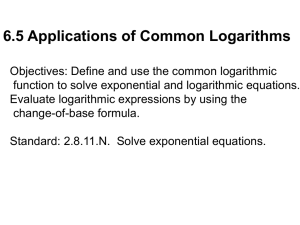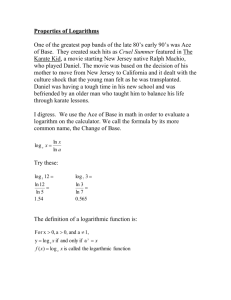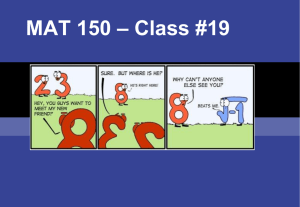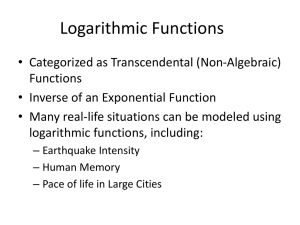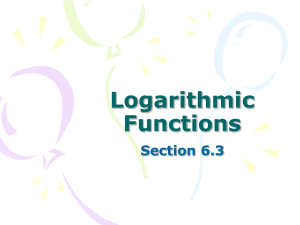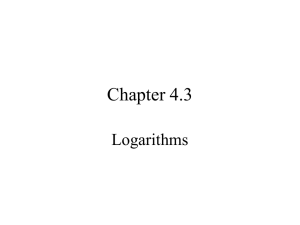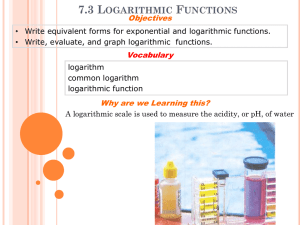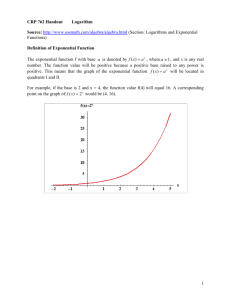Review for Exam #3
advertisement
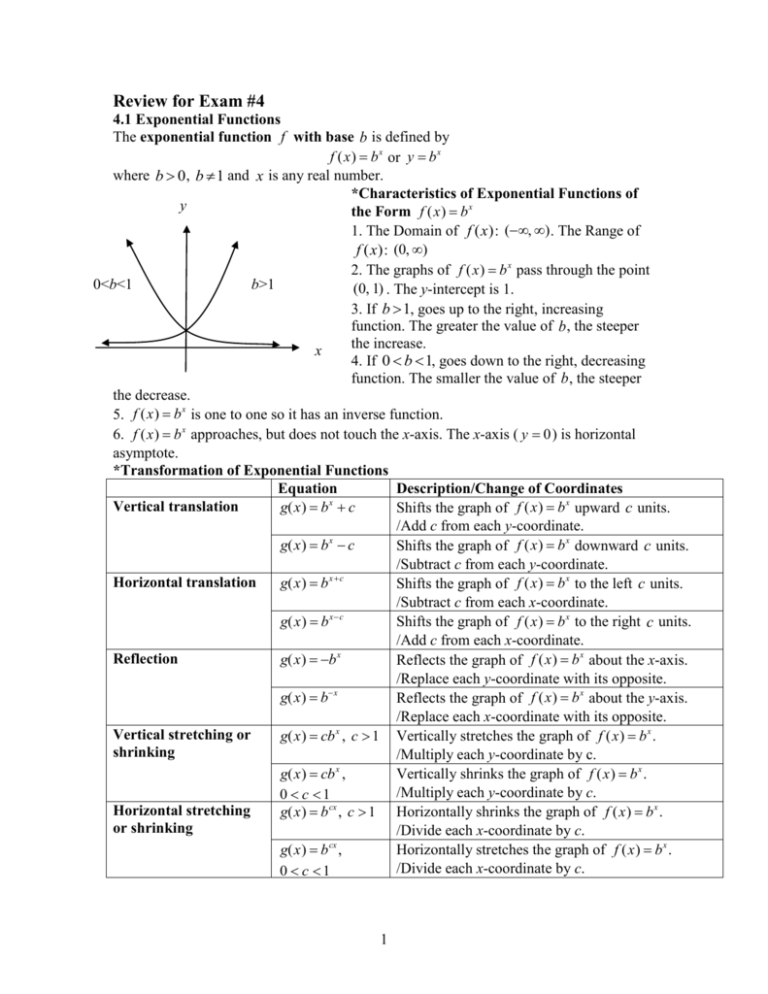
Review for Exam #4
4.1 Exponential Functions
The exponential function f with base b is defined by
f (x) b x or y b x
where b 0, b 1 and x is any real number.
*Characteristics of Exponential Functions of
y
the Form f (x) b x
1. The Domain of f (x) : (, ) . The Range of
f (x) : (0, )
x
2.
The graphs of f (x) b pass through the point
0<b<1
b>1
(0, 1) . The y-intercept
is 1.
3. If b 1, goes up to the right, increasing
function. The greater the value of b , the steeper
the increase.
x
4. If 0 b 1, goes down to the right, decreasing
function. The smaller the value of b , the steeper
the decrease.
5. f (x) b x is one to one so it has an inverse function.
6. f (x) b x approaches, but does not touch the x-axis. The x-axis
( y 0 ) is horizontal
asymptote.
*Transformation of Exponential Functions
Equation
Description/Change of Coordinates
x
Vertical translation
g(x) b c
Shifts the graph of f (x) b x upward c units.
/Add c from each y-coordinate.
x
g(x) b c
Shifts the graph of f (x) b x downward c units.
/Subtract
c from each y-coordinate.
x c
Horizontal translation
g(x) b
Shifts the graph of f (x) b x to the left c units.
/Subtract
c from each x-coordinate.
x c
g(x) b
Shifts the graph of f (x) b x to the right c units.
/Add c from
each x-coordinate.
x
Reflection
g(x) b
Reflects the graph of f (x) b x about the x-axis.
/Replace
each y-coordinate with
its opposite.
x
x
g(x) b
Reflects the graph of f (x) b about the y-axis.
/Replace each
x-coordinate with its opposite.
x
Vertical stretching or
g(x) cb , c 1 Vertically stretches the graph of f (x) b x .
shrinking
/Multiply each
y-coordinate by c.
x
g(x) cb ,
Vertically shrinks the graph of f (x) b x .
/Multiply each y-coordinate
0
c 1
by c.
cx
Horizontal stretching
g(x) b , c 1 Horizontally shrinks the graph of f (x) b x .
or shrinking
/Divide each x-coordinate
by c.
cx
g(x) b ,
Horizontally stretches the graph of f (x) b x .
/Divide each x-coordinate
0
c 1
by c.
1
Example 1) The equation f (x) 17.48e 0.0027x describes the average hourly wage for
construction workers x years after 2000. Estimate (to the nearest cent) the average hourly
wage in 2010.
Example 2) Find the equation represents the transformation of the graph f (x) 3x after
a horizontal shift of 4 units left, a reflection about y-axis, followed by a vertical shift of 5
units up?
1 x 5
Example 3) Let h(x) 3 .
4
(a) Write the domain and range of h in interval notation.
(b) Write the equation of the asymptote for the graph of h(x) .
(c) Is the graph of h(x) increasing or decreasing?
2
*Formulas for Compound Interest
After t years, the balance, A, in an account with principal P and annual interest rate r (in
decimal form) is given by the following formulas:
r
1. For n compounding per year: A P1
n
2. For continuous compounding: A Pe rt
nt
Example 4) When $500 is invested in an account that earns 5.75% annual interest,
compounded quarterly, find the accumulated value after 4 years (to the nearest cent).
How about if compounded continuously?
4.2 Logarithmic Functions
For x 0 and b 0 , b 1,
y log b x is equivalent to b y x .
The function f ( x) log b x is the logarithmic function with base b.
*Properties Involving One
1. log b b 1
2. log b 1 0
*Inverse Properties of Logarithms
For b 0 and b 1,
log b b x x
b logb x x
*Graphs of Logarithmic Functions
A logarithmic function is the inverse of an exponential function. I means that the graph of
the logarithmic function is a reflection of the graph of the exponential function about the
line y x .
y
y
y bx
y bx
x
x
y log b x
b 1
0 b 1
3
y log b x
*Characteristics of the Graphs of Logarithmic Functions of the Form f ( x) log b x
1. The x-intercept is 1. There is no y-intercept.
2. The y-axis ( x 0 ) is a vertical asymptote. As x 0 , log b x or .
3. If b 1 , the function is increasing. If 0 b 1, the function is decreasing.
4. The graph is smooth and continuous. It has no sharp corners or gaps.
*Transformation of Logarithmic Functions
Equation
Description/Change of Coordinates
Vertical
Shifts the graph of f ( x) log b x upward c units.
g ( x) log b x c
translation
/Add c from each y-coordinate.
Shifts the graph of f ( x) log b x downward c units.
g ( x) log b x c
/Subtract c from each y-coordinate.
Horizontal
g ( x) log b ( x c)
Shifts the graph of f ( x) log b x to the left c units.
translation
/Subtract c from each x-coordinate.
Shifts the graph of f ( x) log b x to the right c units.
g ( x) log b ( x c)
/Add c from each x-coordinate.
Reflection
Reflects the graph of f ( x) log b x about the x-axis.
g ( x) log b x
/Replace each y-coordinate with its
opposite.
g ( x) log b ( x)
Reflects the graph of f ( x) log b x about the y-axis.
/Replace each x-coordinate with its opposite.
Vertical
Vertically stretches the graph of f ( x) log b x .
g ( x) c log b x , c 1
stretching or
/Multiply each y-coordinate by c.
shrinking
Vertically shrinks the graph of f ( x) log b x .
g ( x) c log b x ,
/Multiply each y-coordinate by c.
0 c
1
Horizontal
g ( x) log b cx , c 1
Horizontally shrinks the graph of f ( x) log b x .
stretching or
/Divide each x-coordinate by c.
shrinking
g
(
x
)
log
cx
,
Horizontally stretches the graph of f ( x) log b x .
b
/Divide each x-coordinate by c.
0 c 1
1
Tip: follow the changes of 3 points {( , 1), (1, 0), (b, 1)} and asymptote ( x 0 ) of
b
f (x ) through
the
transformations.
*The Domain of a Logarithmic Function
The domain of a logarithmic function of the form f ( x) log b x is the set of all positive
real numbers, (0, ) . The domain of f ( x) log b g ( x) consist of all x for which
g ( x) 0 .
*Common Logarithms
f ( x) log 10 x log x
*Natural Logarithms
f ( x) log e x ln x
4
Example 5) Determine if the first expression is larger, smaller or equal to the second
expression.
(a) log 2 (log 5 5)
0
log 3 27
(b)
1
log 3 9
(c) log 5 20
log 20 5
1
(d) log 2
0
8
Example 6) What is the coordinate of the x-intercept of f (x) log 3 (x 5) 2?
Example 7) What is the domain of f (x) 3 ln( 5 x) ?
4.3 Properties of Logarithms
*Expanding Logarithmic Expressions
For M 0 and N 0 :
1. log b (MN ) log b M log b N
Product rule
M
2. log b log b M log b N Quotient rule
N
3. log b M p p log b M
Power rule
*Condensing Logarithmic Expressions
For M 0 and N 0 :
1. log b M log b N log b ( MN )
M
2. log b M log b N log b
N
p
3. p log b M log b M
Product rule
Quotient rule
Power rule
*The Change-of-Base Property
log a M
log b M
log a b
5
Example 8) Expand the expression below as much as possible.
5
x
log 4
3
16
(
x
7
)
Example 9) Write the following expression as a single logarithm whose coefficient is 1.
1
(ln b 4 ln c ln 5)
4
Example 10) Write the expression below as a single term that does not contain
logarithms. Simplify your answer as much as possible.
6 4 log6 x 3 log6 xy
Example 11) Use the calculator to evaluate log 0.3 19 . Round your answer to 4 decimal
places.
4.4 Exponential and Logarithmic Equations
*Exponential Equations
- Solving Exponential Equation by Expressing Each Side as a Power of Same Base
If b M b N , M N .
1. Rewrite the equation in the form b M b N .
2. Set M N .
3. Solve for the variable.
- Using Natural Logarithm toSolve Exponential Equations
1. Isolate the exponential expression.
2. Take the natural logarithm on both sides of the equation.
3. Simplify using one of the following properties:
ln b x x ln b or ln e x x .
4. Solve for the variable.
6
*Logarithmic Equations
- Using the Definition of a Logarithm to Solve Logarithmic Equations
1. Express the equation in the form log b M c .
2. Use the definition of a logarithm to rewrite the equation in exponential form:
log b M c means b c M .
3. Solve for the variable.
in the original equation. Include in the solution set only
4. Check proposed solutions
values for which M 0 .
Property of Logarithms
- Using the One-to-One
to Solve Logarithmic Equations
1. Express the equation in the form log b M log b N . This form involves a single
logarithm
whose coefficient is 1 on each side of the equation.
2. Use the one-to-one property to rewrite the equation without logarithms:
If log b M log b N , then M N .
3. Solve for the variable.
4. Check proposed solutions in the original equation. Include in the solution set only
values for which M 0 and N 0.
Example 11) The Smith family won $12,000 in a raffle and wants to invest it for their
child’s
college fund.
What interest will be needed for this investment grow to $60,000,
compounded continuously, after 18 years? Write your answer as a percent and round to
the nearest hundredths place.
Example 12) Find the solution set for the equation log 3 x log 3 ( x 8) 2 .
Example 13) Find the exact solution for the equation e 2 x e x 12 0.
Example 14) Find the solution set for the equation below correct to four decimal places.
4 x 2 5x
7


